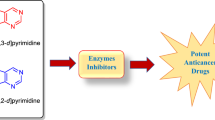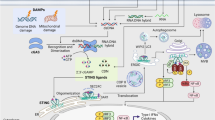Abstract
Circumstantial evidence is presented that chloracetaldehyde is generated from cyclophosphamide by chemical oxidation in vitro with peroxide and might possibly be formed in vivo as a product of cyclophosphamide bioactivation.
Chloracetaldehyde has several attributes of an agent capable of suppressing cellular immunity. Thus it prevents a graft-versus-host reaction (both in vivo and in vitro), is cytostatic and under certain conditions can abrogate an ongoing immunopathy (EAE).
These properties are also exhibited by HN-2 and certain alkylating metabolites of cyclophosphamide.
Similar content being viewed by others
References
N. Sladek,Bioassay and Relative Cytotoxic Potency of Cyclophosphamide Metabolites Generated In Vitro and In Vivo, Cancer Res.33, 1150–1158 (1973).
M. W. Whitehouse, L. Levy andF. J. Beck,Effect of Cyclophosphamide on a Local Graft-Versus-Host Reaction in the Rat: Influence of Sex, Disease and Different Dosage Regimens, Agents and Actions3, 53–60 (1973).
M. W. Whitehouse, M. M. Droge andR. F. Struck,Lymphocyte Deactivation by Cyclophosphamide Metabolites and Mannomustine, Proc. W. Pharmac. Soc.15, 195–199 (1972).
O. M. Friedman andE. Boger,Colorimetric Estimation of Nitrogen Mustards in Aqueous Media: Hydrolytic Behavior of Bis(β-chlorethyl)amine, nor-HN-2, Anal. Chem.33, 906–910 (1961).
R. A. Alarcon andJ. Meienhofer,Formation of the Cytotoxic Aldehyde Acrolein During In Vitro Degradation of Cyclophosphamide, Nature New Biol.233, 250–252 (1971).
B. B. Newbould,Production of Allergic Encephalomyelitis in Rats by Injection of Spinal Cord Adjuvant into the Inguinal Lymph Nodes, Immunology9, 613–614 (1965).
R. C. Gerber, M. W. Whitehouse andK. J. Orr,Effect of Gold Preparations on the Development and Passive Transfer of Experimental Allergic Encephalomyelitis in Rats, Proc. Soc. exp. Biol. Med.140, 1379–1384 (1972).
E. Sawicki andT. R. Hauser,Spot Test Detection and Colorimetric Determination of Aliphatic Aldehydes with 2-Hydrazinobenzothiazole, Anal. Chem.32, 1434–1436 (1960).
E. Sawicki, T. R. Hauser, T. W. Stanley andW. Ebert,The 3-Methyl-2-benzothiazolone Hydrazone Test: Sensitive New Methods for the Detection, Rapid Estimation and Determination of Aliphatic Aldehydes, Anal. Chem.33, 93–96 (1961).
R. A. Alarcon,Flurometric Determination of Acrolein and Related Compounds with m-Aminophenol, Anal. Chem.40, 1704–1708 (1968).
G. L. Ellman,Tissue Sulphydryl Groups, Arch. Biochem. Biophys.82, 70–77 (1959).
G. A. Hamilton, J. W. Hanifin, J. P. Friedman,The Hydroxylation of Aromatic Compounds by Hydrogen Peroxide in the Presence of Catalytic Amounts of Ferric Ion and Catechol. Product Studies, Mechanism, and Relation to some Enzymic Reaction, J. Am. Chem. Soc.88, 5269–5272 (1966).
D. L. Hill, W. R. Laster, Jr., M. C. Kirk, S. El Dareer andR. F. Struck,Metabolism of Isophosphamide and Production of a Toxic Isophosphamide Metabolite, Cancer Res.33, 1016–1022 (1973).
E. D. Peters,Analytical Methods in:Acrolein (Ed. C. W. Smith, Wiley, New York 1962), p. 247–249.
M. W. Whitehouse,Soft Immunodepressants: Drugs to Disarm Over-Enthusiastic Leukocytes. Proc. Symp. ‘Future Trends in Inflammation’, Verona, June 1973.
J. E. Bakke, V. J. Feil, C. E. Fjelstul andE. J. Thacker,Metabolism of Cyclophosphamide by Sheep, (J.) Agr. Food Chem.20, 384–388 (1972).
T. A. Connors, P. B. Farmer, A. B. Foster, A. M. Gilsenan, M. Jarman andM. J. Tisdale,Metabolism of Aniline Mustard, Biochem. Pharmac.22, 1971–1980 (1973).
C. C. Price, A. Pohland andB. H. Velzen,Hydrolysis and Chlorination of Three β-chloroethylamines, J. Org. Chem.12, 308–321 (1947).
R. G. Dickinson andN. W. Jacobsen,A New Sensitive and Specific Test for the Detection of Aldehydes: Formation of 6-mercapto-3-substituted-s-triazolo [4,3,6]-s-tetrazines, J. Chem. Soc. [D], p. 1719–1720 (1970).
N. E. Sladek,Evidence for an Aldehyde Posessing Alkylating Activity as the Primary Cytotoxic Metabolite of Cyclophosphamide, Cancer Res.33, 651–658 (1973).
A. Primack,Amelioration of Cyclophosphamide-Induced Cystitis, J. nat. Cancer Inst.47, 223–227 (1971).
R. A. Alarcon, J. Meienhofer andE. Atherton,Isophosphamide as a New Acrolein-Producing Antineoplastic Isomer of Cyclophosphamide, Cancer Res.32, 2519–2523 (1972).
J. A. Secrist, III, J. R. Barrio, N. D. Leonard andG. Weber,Fluorescent Modification of Adenosine-Containing Coenzymes. Biological Activities and Spectroscopic Properties, Biochemistry11, 3499–3506 (1972).
Author information
Authors and Affiliations
Rights and permissions
About this article
Cite this article
Whitehouse, M.W., Beck, F.J. & Kacena, A. Some (pharmacological) properties of chloracetaldehyde, an oxidation product and potential metabolite of cyclophosphamide. Agents and Actions 4, 34–43 (1974). https://doi.org/10.1007/BF01965490
Received:
Issue Date:
DOI: https://doi.org/10.1007/BF01965490




